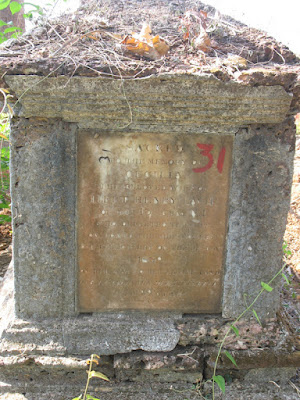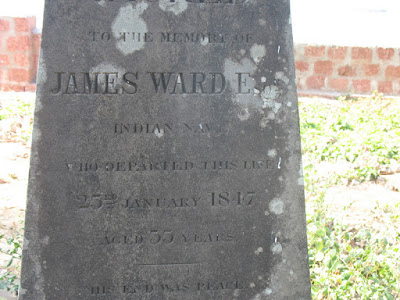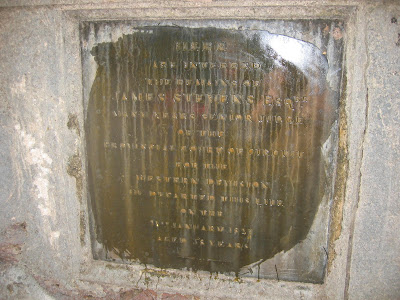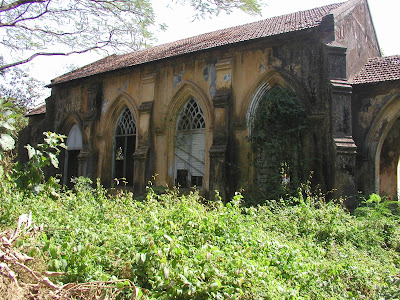 |
| Figure 1, St John's Church, Thalassery in 2009. Photo courtesy Jissu Jacob |
It is widely believed by many that it was Edward Brennan, the Harbour Master at Tellicherry during the 1860's. This "fact" appears in countless websites, tourist guides, etc. etc. but I believe masks a much earlier series of places of worship on the site.
While it is true that Brennan rebuilt the church in the 1860's, his was definitely not the first church at Tellicherry.
 |
| Figure 2. Edward Brennen's memorial plaque inside St. John's Church, Thalassery |
There are several different Christian Churches in Thalassery today. Each one represents a different form of Christianity, Catholic, C.S.I Protestant, & Basle Mission. All make claims for their foundation dates that are at best questionable, and at worse incorrect.
In settlements under the East India Company rule, the official garrison church was therefore always a Protestant Church. However the East India Company always struggled to recruit enough Protestant men to fill its military units, so that in practise there were often large numbers of Indo-Portuguese, Irish & English Catholics serving in these settlements as soldiers and as lower ranking officials. These Catholics were accommodated by Catholic Churches, as was the case at Tellicherry, where St Joseph's Catholic Church was built besides the Protestant Church, both within the outer defensive walls of the fort at Tellicherry that we can all visit today.
One of the best preserved monuments & grave stones is that erected (as it would have originally have been set into the ground vertically, is that of Captain Gaspar Moritz Gleetz 1730-1768.
 |
| Figure 3. Captain Gaspar Moritz Gleetz 1730-1768 |
During the middle of the 18th Century there was huge disruption in Germany caused by the many wars that were taking place there. Germany was not a single country, but was dozens of often mutually antagonistic states. Parts of Germany like Hanover were ruled by the King's of England, who ruled both states. Many German's became full time professional soldiers and officers.
When the British government was mobilising for each new war on Continental Europe, it would need to conscript tens of thousands of often unwilling English, Scots & Irish. These huge recruiting drives increased competition for the available men in the community.
Very often a ban was placed on the EIC in London to stop them recruiting in competition with the British Army, and this forced the EIC to recruit in Germany. They had recruiting agents who travelled into Germany, often up the Rivers Rhine, Elbe and Oder in an attempt to find suitable recruits. They were in competition with similar agents acting on behalf of the Dutch VOC, army & navy, who had similar issues finding enough men to fill their armies both in India, the Spice Islands as well as in Europe
Quedlinburg, where Gaspar came from is a town situated just north of the Harz Mountains in Germany mid way between Hanover & Leipzig. At this period many of the officers in the East India Company infantry companies came from Europe where they had often gained extensive experience during the wars in that part of the World.
 |
| Figure 4. Childhood home of Gaspar Moritz Gleetz |
Modern sources all suggest that Harbour Master Edward Brennan had St John's Church built in the 1860's. This however cannot have been the case as there was a previous church on the site before 1820, constructed by the Reverend Francis Spring, which had been built over the alignment of an earlier wall that encircled the fort facing towards the sea, which had formed part of the defences to the Fort. The fill on either side of the wall had not been adequately compacted on either side of the foundations of the old wall, so that the earlier church broke its back over the old wall, some years before Edward Brennan funded the construction of the current church.
Life expectancy for new arrivals in India during the 18th Century was often less than three years, although those who survived the first three years could stretch to a further twenty years or more in India. Less than 30% of those who arrived from Europe could expect to return there. This means that at least 70% are buried in Tellicherry or nearby. Somewhere around 10 new people would arrive from Europe each year, sometimes it was more, at other times less.
In some other EIC forts like Fort St David, it is known that in the absence of a church, the Gunner's Room was used as a makeshift chapel on the relatively rare occasions that a parson was passing through the settlement or arrived as a chaplain on a passing East India Company ship. Some EIC officers will have taken services for their men too.
Notice the large buildings inside the fort, which have subsequently disappeared. Notice also that there are a number of garden terrace or defensive walls between the fort wall and the sea, in the area where St. John's Church currently stands. It was one of these walls that the Rev. Spring's 1820's church broke its back over.
The East India Company who arrived at Tellicherry in 1699, were taking over an earlier French settlement that was founded in about 1677 in the area that is now covered by the central bazaar, would have been very wary of worshipping in public, for fear of upsetting the religious sensibilities of both the Hindu's and Muslims.
This concern about Indian objections to Christian religion being outwardly conducted was a very serious, so that the EIC Directors in London made a considerable effort to stop missionaries and clergymen from going out to India. This policy remained officially in place until the 1830's.
This policy was often deeply unpopular with many of the EIC officials and men who would have attended church services once a week on Sunday every week of their lives. Many will have lived in homes were the head of the family had a bible, and would say family prayers every evening for his family and his servants.
With death & illness an ever present threat in Tellicherry, many men, especially those who were ill and were close to death will have been very concerned that there was no clergyman to administer to their needs or to administer the Last Rights. Men who were probably not very religious throughout most of their adult life, would suddenly become desperately anxious to be blessed, as it was firmly believed that they would not otherwise get into Heaven.
Christening were not possible, and marriages could not be formally solemnised.
The EIC local employees were however able to get around the official EIC ban or restrictions on clergymen. All along the Malabar coast there were many ports belonging to other countries, or native states, and these ports often had entirely different policies on the presence of priests or parsons in their settlements. Most of these parsons came from Protestant states in Germany, just like Gleetz had. Although they were employed by either the Dutch or English companies, many of these soldiers & parsons were not Dutch or English, but ethnic Germans.
From time to time one of these Dutch / German missionaries would be invited to Tellicherry were they would give services which the garrison and merchants would attend.
Gunner's were a separate part of the military garrison, and they considered themselves superior to the infantry. They received higher pay, and their NCO's were allowed to distill Arrack which they could retail to the visiting crews of EIC ships anchored in the bay.
They had their own room inside the Fort. The gunners were never expected to leave the settlement, having to live next to the all important cannon, on whose effectiveness the survival of the settlement depended, unlike the infantry who could be sent elsewhere. The gunners barrack rooms were generally much better quality than those allocated to the infantry.
It is known that at the same period, in other forts like Fort St David's were my 5 x great grandfather Captain John De Morgan (a French Huguenot, who served in the EIC garrison at Fort St David from 1711 until 1746), that officers like De Morgan would hold weekly services for their men inside the Gun Room, in much the same way that Royal Navy officers often do to this day in the absence of a chaplain.
 |
| Figure 7. Captain John Sibbald of the 34th Regiment who died in December 1843 |
By the 1780's with the preaching of men like John Wesley, the Established Protestant Church began to reform itself. It did however split as a result, in the officially recognised church and into the Non-Conformist churches like John Wesley's Methodist Church. The increased competition from the newer churches caused the Established Anglican Church to have to reform itself, and to reinject itself with new energy. One of the effects of this reconfiguration of the church in England was renewed pressure on the EIC Directors to allow missionaries and clergy to officially travel out to India directly in EIC shipping. The Reverend Francis Spring was one of the first of these early "official" Anglican Protestant missionaries from this new generation of active and dedicated missionaries and clergy.
Spring was sent to Tellicherry and later on to Cannanore where he played an important role in establishing both of the St. John's churches in those locations.
Spring was sent to Tellicherry and later on to Cannanore where he played an important role in establishing both of the St. John's churches in those locations.
Up until about 1812 a substantial garrison had existed in both Tellicherry and Cannanore. By 1815 it appears that a decision was taken to move the army out of Tellicherry to Cannanore, where the existing site and fortifications could more easily accommodate the garrisons and prisons required.
However, the judicial community that was living in large comfortable house that they had built or acquired in Tellicherry were very reluctant to follow the garrison to Cannanore. It is believed that only about seven judicial officials remained in the town plus the harbour master by 1818.
We believe that Spring had arrived in Tellicherry in about 1817, and that he set about building a new church on the site of the former much older (1720?) garrison graveyard. This was to replace the old "Gun Room." As Tellicherry was rapidly emptying of the churches potential source of a congregation, the raising of funds and the construction of the church may have taken a while, and the work may have been carried out in a less than competent manner. This may account for the fragile nature of the structure.
At the mean time the garrison at Cannanore probably numbered in excess of 500 European men, and needed a church of its own. The Rev. Spring became involved in promoting that church as well.
Spring himself appears to have left both Cannanore & Tellicherry during 1823 heading home to England. Responsibility for his churches was transferred to the Church Missionary Society [CMS], who subsequently supplied funding an clergy from England. Some of their reports are now available online dating from the 1820's, and I will explore those in later posts.
As many of you are aware I have had an interest in the Thalassery and surrounding districts including the Wayanad for many years, and this has led to my becoming a focal point of contact for many other people who have similar connections with the town and the surrounding areas.
Over the years these people have included former sepoys, teachers, bakers of the famous Victoria sponge cake, Mappila merchants, temple authorities as well as the descendants of former EIC officials and army personnel who served there over the years.
Recently I have become involved in an informal project locally to try to improve the condition of several of local heritage sites in the town, which is succeeding in drawing a much greater of level of interest in Thalassery & internationally has been much than I had originally been expecting.
As I was taught at school, Brutus said to Cassius in Shakespeare's 'Julius Caesar'
“There is a tide in the affairs of men. Which, taken at the flood, leads on to fortune”
Whilst I have not been a great fan of Shakespeare since I left school,that quotation has remained a very effective maxim to deploy in my subsequent life.
I want to see if I can build on the momentum that people like Biju Thomas have been very successfully building up locally, especially as I have been getting a lot of very positive responses from the local community in Thalassery.
I am trying to get into a position to hold a series of launch events in the autumn of this year, or January 2023, when I hope to be in the town for several weeks, working on my own research projects.
Vaughan was the Principle Collector at Tellicherry throughout most of the 1820's and 1830's.
One of the key sites that can be visited today is the former Protestant garrison church at St John’s Tellicherry. This church is sandwiched between the old East India Company Fort and the sea. When I was last in Tellicherry in 2006, it was in an appalling state.
Fortunately, in 2009 the local church and community authorities undertook a very thorough restoration of the structure of the church itself. This work is described in the following two blog posts that I made in 2009.
http://malabardays.blogspot.com/.../tellicherry-church...
and
http://malabardays.blogspot.com/.../tellicherry-church...
and
http://malabardays.blogspot.com/.../tellicherry-church...
Since 2009 the church has had a number of further restoration efforts made, and the grounds have been maintained periodically.
 |
| Figure 10. Cecilia Lawrie's Tomb |
 |
| Figure 11. St John's Church under restoration in 2007. Photo by Lindsay Gething. |
The next door school, St Joseph's Higher Secondary School, Thalassery which has origins as an Anglo-Indian school going back to the 18th century, and which is run under the management of Latin Diocese of Kannur, has taken an interest in St John’s Church which is located in the heart of the town of Thalassery beside the original Tellicherry Fort.
The Bishop of CSI church for North Kerala Diocese has recently expressed his interest in the project and wishes to talk about how to ready the British Heritage assets in his churches for the proposed north Kerala tourism development in a way that would be helpful to the society and his community Members. Depending on the response from interested parties, we might try to develop a process to roll out our project to encompass other nearby churchyards from other denominations. If you have connections with Tellicherry or have ancestors buried in these churches, and feel that you might like to take part please email me at balmer.nicholas@gmail.com
 |
| Figure 12. Eliza Wills, wife of Henry Crewe who died at Tellicherry in 1874 |
At present I have no knowledge of Henry Crewe's life. Does anybody know anything about him?
 |
| Figure 13. James Ward Esq, Indian Navy |
As they approached retirement age, many former Indian Navy officers left their ship based activities for shore based posts and became Harbour Masters, so it is entirely possible that he was Harbour Master at Tellicherry at some point between Mr. Oakes and Mr. Brennen who were also Harbour Masters at Tellicherry. C.R. Low also mentions a Lieutenant C.Y. Ward, who compiled the "Gulf of Aden Pilot" published by the Admiralty in 1863. He might be either James Ward's brother or even son.
Many people who had become seriously ill in other parts of India or the Indian Ocean, made sea voyages to Tellicherry from places like Bombay. The voyage alone was believed to be good for you, and was often prescribed by Company Doctors, and the voyage often cured many illnesses. Tellicherry had been seen for many years as being a particularly healthy station compared with most other coastal EIC port settlements.
As Ootacamund developed into a summer hill station by the 1840's, many people from places like Bombay who were already ill travelled via Tellicherry or Cannanore to Ootacamund via the Wayanad, and their letters and diaries often contain some of the best descriptions of the Tellicherry area at that time. It is possible that James Ward had been passing through Tellicherry when he died.
 |
| Figure 14. A close up shot of the inscription on James Ward's monument |
 |
| Figure 15. Elizabeth Frances Schmidt. Schmidt is a German name that means smith. |
Many earlier tomb stones have probably crumbled or been pushed aside in recent years.
 |
| Figure 16. James Crawford (possibly). He may have been related to Mr H Crawford who was Commercial Agent for the Travancore Government at Alleppey |
 |
| Figure 17. James Stevens, who was the senior judge at Tellicherry in the early 1800's. |
 |
| Figure 18. James Stevens grave monument. |
James Stevens modern descendants live in Australia, some of them visited this tomb about a decade ago. The dark stain was caused by the use of water to try to make the text readable. It will have dried away shortly afterwards. You can see how the heavy rains and sun are taking the toll of the chunam plaster exposing the laterite blockwork underneath.
 |
| Figure 19. Margaret Eleanor John, who was born in 1837 and died in 1911. |
 |
| Figure 20. Mary Brown, daughter of Francis Carnac Brown. This photo dates from quite recently, and shows how it was over painted in recent years. |
 |
| Figure 21. This was Mary Brown's plaque a few years earlier. It is a great pity that it was painted over. I wonder if the paint could be removed? |
By seeking to use slave labour in 1797, Murdoch Brown was following centuries old, local custom and practice.
Thomas Baber who had only relatively recently arrived from England where he appears to have absorbed the early campaigns of anti-slavery campaigners of the Clapham Sect. He went on to take out a private prosecution against Brown in the Madras High court.
Brown organised for an army officer (with a severe debt problem, and a reputation for fighting duels to try to pay off his crippling debt.) called Billy Robinson to challenge Baber to a duel that was fought.
As a young officer Francis Carnac Brown also challenged Baber to a duel a couple of years later. Brown and his two accomplices were prosecuted, again privately in Madras, and to the disgust of many in court Thomas Baber secured a successful prosecution, sending Brown and the other two to prison.
Francis Carnac Brown seems to have quickly recovered from his time in prison, and as an older and no doubt wiser man, he went on to play a major role in establishing planting in the Wayanad and elsewhere. He wrote several really interesting books on planting & other issues facing EIC expats in late 1830's Kerala.
One can only imagine what the scene was like in this church with the Brown family sat in one pew and the Baber family nearby in another pew.
Does anybody know where Polly Coon was in Tellicherry?
 |
| Figure 23. St John's Church Tellicherry in 2006-2007 |
This was the state of St John's Church when I visited in in 2006. At that time I though that the church was probably beyond recall.
The growth of scrub in the grave yard was chest high when I climbed into the grave yard. The place was full of mongooses, and my dear local host was beseeching me to get out of the graveyard as fast as possible, as it must be full of snakes to be able to support so many mongooses.
The growth of scrub in the grave yard was chest high when I climbed into the grave yard. The place was full of mongooses, and my dear local host was beseeching me to get out of the graveyard as fast as possible, as it must be full of snakes to be able to support so many mongooses.
Thankfully the community at Thalassery have taken substantial steps to look after this church in recent years, and they should be thanked for having done so much to preserve this part of our shared heritage.
Especial thanks are due to Dr. Denny, the Principle, and the pupils of St. Joseph's Higher Secondary School who are looking after the graveyard currently.
Especial thanks are due to Dr. Denny, the Principle, and the pupils of St. Joseph's Higher Secondary School who are looking after the graveyard currently.






9 comments:
Intersting to compile a history of mysterious, unknown and abandoned church origins in Southern India, especially those scattered across really remote rural areas. Know one in the farmlands of Kayathar, Tirunelveli, next to an old abandoned airstrip.
Very informative and interesting article. Glad that I stumbled upon this blog. Hearty congratulations to the author.
Thank you for sharing all your research. Murdoch Brown is my 5x great grandfather. I am particularly researching my maternal line, and wonder if you know any more about Eliza King who he married in 1791 at Tranquebar. I would like to know more about her parentage. I think you said in another blog that she was French? Thank you.
Hello, I'm also descended from Murdoch Brown, he is my 6x grandfather. I too am looking into Eliza King and her parents. I know that Eliza studied in a convent school in St Omer (France). Do you know her parents names? Ronald Brighouse
Hello Ronald, no I don’t. This is as far as I got:
Eliza King (great great great great great GRANDMOTHER) who was French and married polymath Murdoch Brown in 1791 at Tranquebar. Was educated in a convent at St Omer 1790. Children: Francis Samuel Carnac Brown, daughters Maria Jane Brown, Caroline Brown, Eliza Agnew Brown 1794-1835, Agnes Brown, and Julia Brown. Marriage Announcement: Murdoch Brown, Esq., Imperial Consul General For The Malabar Coast, To Miss Eliza King. Birth. On 'Vvs-Dnefshiy | Caledonian Mercury | Thursday 23 June 1791 | British Newspaper Archive
One of Murdoch Brown’s descendants, Marianne is married to Michael Hannyngton descendant of JC Hannyngton who retired as Resident and also administered Tellicherry and other Malabar provinces. They live in Oxford.
USA UK CANADA FRESH FULLZ SELL
SSN NIN SIN Info with all other details
Bulk quantity available & fresh database
Verified & Legit Info guaranteed
Tele Gr@m > @ leadsupplier , @ killhacks
What's App > (+1).. 727..... 788.... 6129..
Skype > @ peeterhacks
E mail > hacksp007 at g-mail dot com
FULLZ DESCRIPTION:
SSN DOB DL ADDRESS USA FULLZ
SIN DOB ADDRESS MMN PHONE EMAIL CANADA FULLZ
NIN DOB DL ADDRESS SORT CODE & ACCOUNT NUMBER UK FULLZ
High Credit Scores pros Fullz (700+ scores)
Young & Old age fullz (2009+ & 1960 below)
Real|Original DL|ID scan front back with selfie
DL Scan front back with SSN USA
CC with CVV Fullz
Dumps with Pin 101 & 202 with tutorials
TOOLS AVAILABLE:
SMTP|RDP|SHELLS|C-panels
Web-mailers|SMS Bomber|Bulk Email Sender
Carding Tools & Tutorials
Sc@m Pages & Sc@m page scripting
Sp@mming Tools & tutorials with leads
All genuine stuff will be provided
Available 24/7 on all time zones
Crypto Payments accepted only
Discounts available for bulk info buyers
Thanks! I appreciate your effort and I am really looking forward to your next post. Bishop Dwight Reed
Residential construction Fort St. John.
Gridline Projects LTD is a trusted construction company in Fort St. John, BC, specializing in project management, renovations & general contracting.
To Get More Information - Gridlinepro.ca
Post a Comment